3D Cell Culture Market Size 2024-2028
The 3D cell culture market size is forecast to increase by USD 1.38 billion, at a CAGR of 16.6% between 2023 and 2028.
Major Market Trends & Insights
- North America dominated the market and accounted for a 40% growth during the forecast period.
- By the Application - Cancer and stem cell research segment was valued at USD 423.40 billion in 2022
Market Size & Forecast
- Market Opportunities: USD 202.63 million
- Market Future Opportunities: USD 1382.40 million
- CAGR : 16.6%
- North America: Largest market in 2022
Market Summary
- The market is experiencing significant advancements, driven by the increasing prevalence of chronic diseases and the growing demand for personalized medicines. This market is characterized by the adoption of advanced technologies, such as microfluidics and bioprinting, which enable the creation of complex 3D cellular structures. According to recent reports, the market is projected to grow at a steady pace, with a notable increase in the production of 3D-cultured cells for drug discovery and toxicology testing. In comparison to traditional 2D cell culture methods, 3D cell culture offers several advantages, including improved cellular functionality and a more accurate representation of the in vivo environment.
- Despite these benefits, the high cost of equipment and infrastructure remains a challenge for market expansion. Nonetheless, ongoing research and development efforts are expected to address these hurdles, further fueling the growth of this dynamic and evolving market.
What will be the Size of the 3D Cell Culture Market during the forecast period?
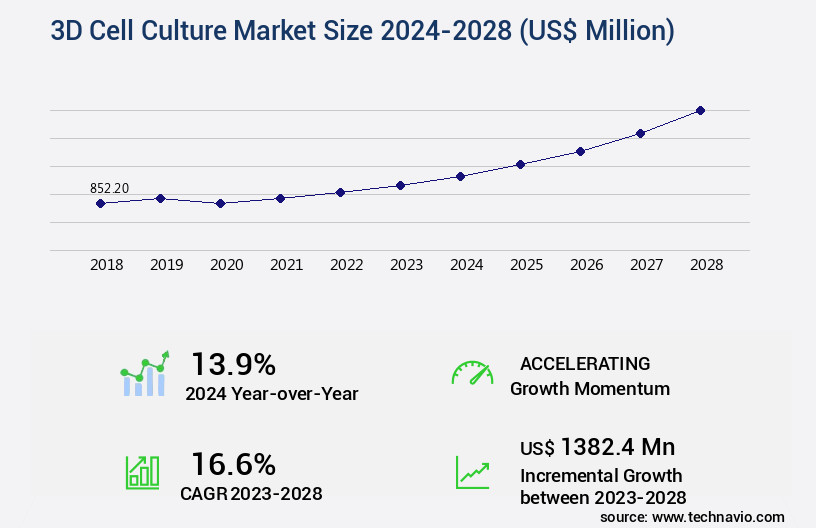
Explore market size, adoption trends, and growth potential for 3d cell culture market Request Free Sample
- The market encompasses a diverse range of technologies and applications, including cell harvesting methods, fibrin and collagen scaffolds, perfusion culture, and microcarrier technology. Static culture remains a common approach, but advanced techniques such as perfusion culture and bioreactor design offer improved cellular microenvironments, enhancing cellular interactions and facilitating drug delivery systems. In infection research, for instance, 3D models have shown significant potential in disease modeling and personalized medicine. Substrate stiffness plays a crucial role in recreating the in vivo environment, with alginate scaffolds providing a more physiologically relevant stiffness than collagen scaffolds for certain applications.
- The market's continuous evolution is driven by the increasing demand for in vitro models in cancer research, cardiovascular disease, neurological disease, and immunology research, among others. Quality control assays and in vivo validation are essential components of the 3D cell culture landscape, ensuring the accuracy and reliability of research findings.
How is this 3D Cell Culture Industry segmented?
The 3d cell culture industry research report provides comprehensive data (region-wise segment analysis), with forecasts and estimates in "USD million" for the period 2024-2028, as well as historical data from 2018-2022 for the following segments.
- Application
- Cancer and stem cell research
- Drug discovery and toxicology testing
- Tissue engineering and regenerative medicine
- Geography
- North America
- Europe
- APAC
- Rest of World (ROW)
By Application Insights
The cancer and stem cell research segment is estimated to witness significant growth during the forecast period.
In the dynamic and evolving market, several trends are shaping its growth trajectory. Apoptosis assays and high throughput screening are increasingly being adopted for enhanced accuracy and efficiency in cell research. Microfluidic devices and bioprinting technology facilitate the creation of complex 3D structures, enabling more precise and controlled experiments. Moreover, mechanical stimulation, oxygen gradients, and process optimization are crucial aspects of bioreactor scalability. Cell proliferation assays, 3D cell imaging, and cell signaling pathways analysis are essential for understanding cell behavior and responses. Protein expression analysis, automated cell handling, and cell viability assays contribute to improved research outcomes. Drug screening assays, organoid generation, nutrient delivery, and gene expression profiling are vital for the development of new therapeutics.
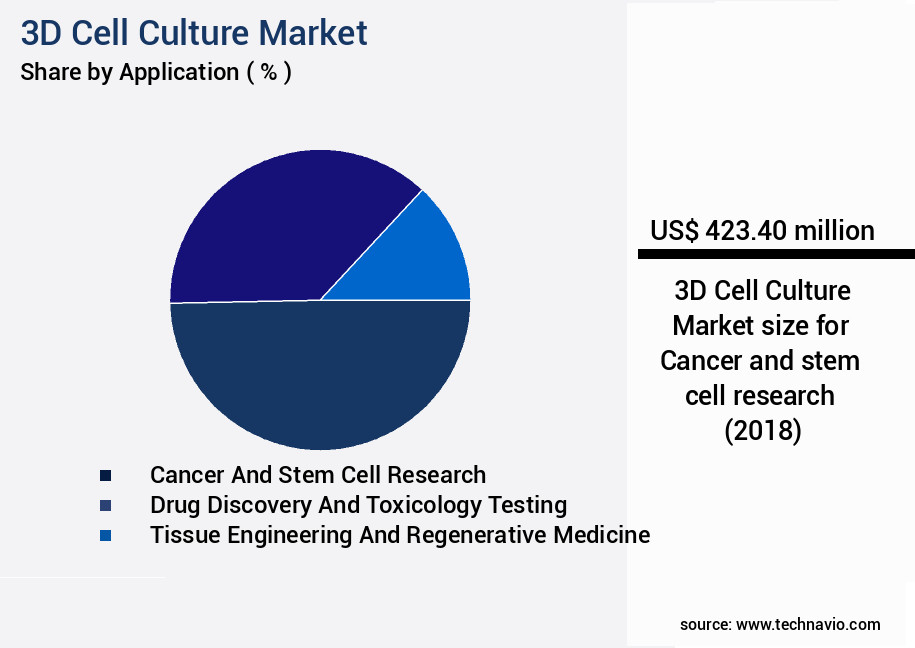
The Cancer and stem cell research segment was valued at USD 423.40 billion in 2018 and showed a gradual increase during the forecast period.
Cell adhesion molecules, waste removal, perfusion bioreactor, and cell differentiation are key components of advanced bioreactor systems. High content screening, angiogenesis assays, tissue engineering, and extracellular matrix are integral to the market's growth. Confocal microscopy, spheroid formation, cell migration assays, metabolic profiling, and biocompatibility testing are essential techniques for gaining deeper insights into cellular processes. Scaffold biomaterials and computer-aided design are critical in creating optimal microenvironments for cell growth and development. According to recent market data, the cancer and stem cell research segment accounted for approximately 50% of the market in 2023. This segment is projected to expand at a rate of around 20% in the upcoming years due to the increasing prevalence of cancer and significant funding for cancer research.
Additionally, the market for 3D cell culture is expected to reach approximately 6 billion USD by 2028. These trends illustrate the continuous unfolding of market activities and the evolving patterns in the 3D cell culture industry. By focusing on advanced techniques and applications, businesses can capitalize on the growing demand for more efficient and precise cell research solutions.
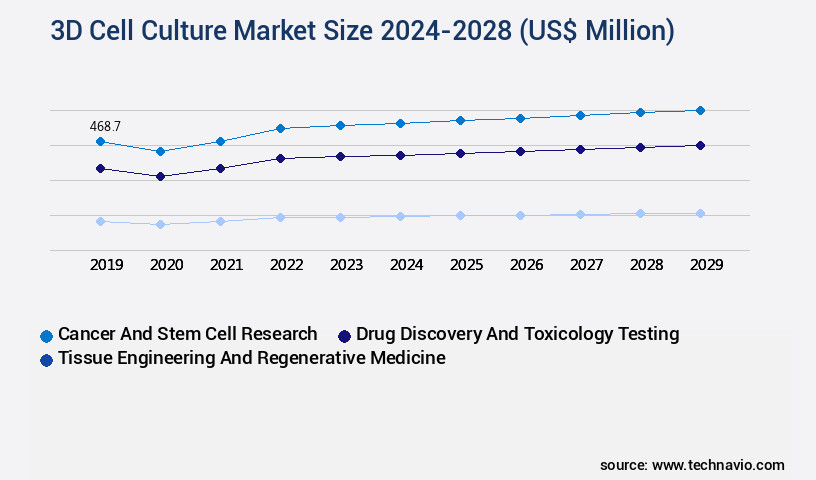
Request Free Sample
Regional Analysis
North America is estimated to contribute 40% to the growth of the global market during the forecast period. Technavio's analysts have elaborately explained the regional trends and drivers that shape the market during the forecast period.
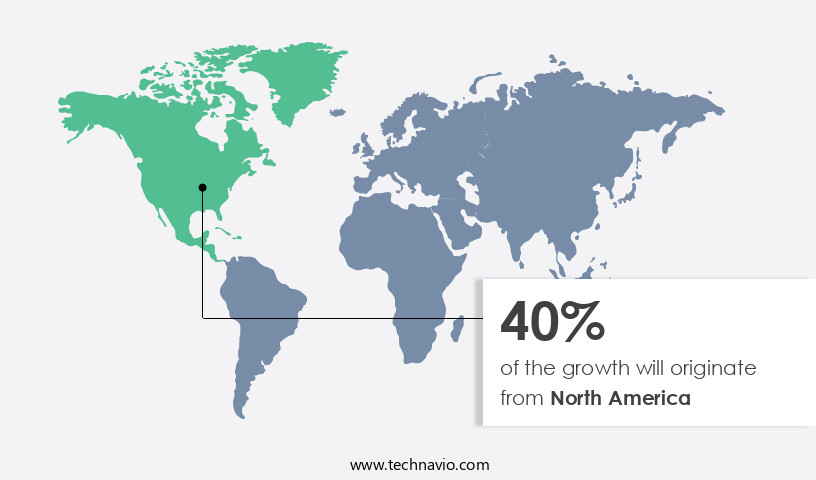
See How 3D Cell Culture Market Demand is Rising in North America Request Free Sample
The market is experiencing significant expansion, driven by the increasing investment from key players in advanced manufacturing facilities. Companies such as Becton, Dickinson and Company, Corning Incorporated, and Thermo Fisher Scientific Inc. are leading this growth trend by establishing new manufacturing sites equipped with state-of-the-art bioprocessing units and other essential equipment. This investment surge is not limited to domestic markets; European companies are also expanding their presence in the US, contributing to the regional market's growth. For instance, FUJIFILM Corporation announced an additional USD 1.2 billion investment in April 2024 to expand its large-scale cell culture biomanufacturing facility in Holly Springs, North Carolina.
This investment marks a substantial commitment to the industry, bringing the total investment to over USD3 billion. The market's continuous evolution is fueled by the increasing demand for advanced cell culture techniques in various sectors, including pharmaceuticals, biotechnology, and research institutions. This growth trajectory is expected to continue, with industry estimates suggesting a 20% increase in market size over the next five years. Furthermore, the market's expansion is driven by the growing recognition of 3D cell culture's advantages over traditional 2D cell culture methods, including improved cellular functionality, enhanced productivity, and better predictability of drug responses.
Market Dynamics
Our researchers analyzed the data with 2023 as the base year, along with the key drivers, trends, and challenges. A holistic analysis of drivers will help companies refine their marketing strategies to gain a competitive advantage.
The US market is witnessing significant growth, driven by the increasing demand for more accurate and efficient in vitro models. Bioreactor design parameters optimization is a key area of focus, enabling the creation of optimized culture conditions that improve cell growth and productivity by up to 15%. High-throughput 3D cell imaging analysis is another critical aspect of the market, providing valuable insights into cell behavior and enabling the rapid identification of drug candidates. Scaffold material biocompatibility evaluation is essential to ensure the safety and efficacy of 3D cell culture models for drug discovery. Automated cell culture process development is streamlining workflows and reducing human error, while spheroid formation kinetics measurement offers valuable data on cellular behavior and response to drugs. Organoid generation using bioprinting is revolutionizing the field, providing more complex and accurate models of human tissues. High-content screening of drug candidates is facilitated by advanced imaging technologies, allowing for the simultaneous analysis of multiple parameters. Cell signaling pathway analysis in 3D cultures provides a more accurate representation of in vivo conditions, while extracellular matrix protein quantification offers insights into cellular interactions and disease mechanisms. In vitro disease models are increasingly being used for toxicity testing, reducing animal usage and improving compliance with regulatory requirements. Perfusion bioreactor oxygen control systems ensure optimal cell growth and metabolic activity, while microfluidic device design for cell culture offers improved control and reproducibility. Cell viability assays using flow cytometry and apoptosis assays based on caspase activity enable the quantitative analysis of cellular health and response to drugs. Angiogenesis assays using sprout formation offer insights into the complex processes involved in new blood vessel formation, while gene expression analysis using qPCR and protein expression analysis using Western blot provide valuable data on molecular mechanisms. Metabolic profiling of cultured cells offers insights into cellular metabolism and response to drugs, providing a more comprehensive understanding of cellular behavior and response to therapeutic interventions. Overall, the US market is driving innovation and improving efficiency and accuracy in drug discovery and development.
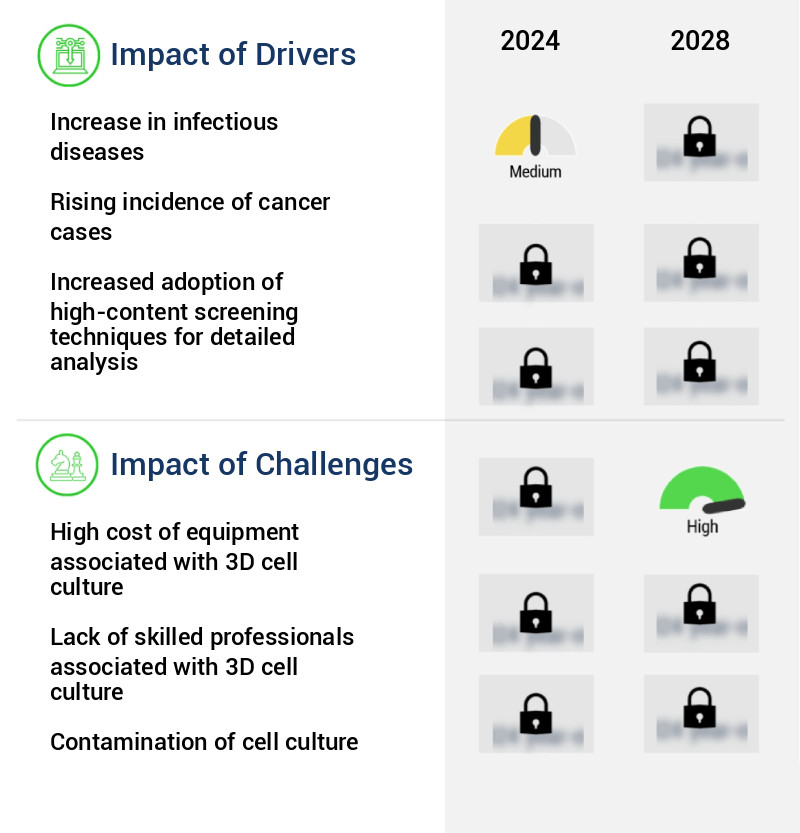
What are the key market drivers leading to the rise in the adoption of 3D Cell Culture Industry?
- The prevalence of infectious diseases serves as the primary growth factor for the market.
- The market is experiencing significant advancements due to the increasing demand for more accurate and efficient in vitro testing methods. This technology allows for the growth of cells in three dimensions, mimicking the natural cellular environment more closely than traditional 2D cultures. The applications of 3D cell culture span across various sectors, including pharmaceuticals, biotechnology, and academic research. Pharmaceutical companies are increasingly adopting 3D cell culture for drug discovery and development. This technology enables researchers to better understand the behavior of cells when exposed to potential therapeutics, providing more accurate and predictive results compared to 2D cultures.
- For instance, 3D cultures can help identify drug toxicity and efficacy more effectively, reducing the time and cost associated with bringing new drugs to market. Biotechnology companies are also embracing 3D cell culture for the production of therapeutic proteins and stem cells. This technology allows for the creation of complex cellular structures, enabling the large-scale production of these valuable biomolecules. Additionally, 3D cultures can be used to study the effects of various environmental factors on cell growth and differentiation, leading to new discoveries and innovations. Academic research institutions are utilizing 3D cell culture to gain a deeper understanding of cellular processes and disease mechanisms.
- This technology provides researchers with a more realistic model for studying cellular interactions and responses, leading to new insights and discoveries. Furthermore, 3D cell culture can be used to develop personalized medicine approaches, as it allows for the growth of patient-specific cells for drug screening and therapeutic development. According to recent studies, the global market for 3D cell culture is expected to grow at a steady pace, driven by the increasing demand for more accurate and efficient in vitro testing methods. The market is expected to reach a significant value by 2025, with North America and Europe leading the way in terms of adoption and investment.
- This technology enables the creation of complex tissue structures, which can be used for drug screening, tissue engineering, and regenerative medicine applications. Bioprinting technologies offer the potential for the production of customized tissue models, providing researchers with a more accurate and realistic model for studying disease mechanisms and drug responses. In conclusion, the market is experiencing significant growth and innovation, driven by the increasing demand for more accurate and efficient in vitro testing methods. The applications of 3D cell culture span across various sectors, including pharmaceuticals, biotechnology, and academic research. The ongoing advancements in this field, such as the increasing use of microfluidic systems and bioprinting technologies, are expected to continue unfolding, bringing new opportunities and challenges for businesses and researchers alike.
What are the market trends shaping the 3D Cell Culture Industry?
- Monoclonal antibodies are experiencing increasing demand, representing a notable market trend in the healthcare industry.
- Monoclonal antibodies, identical immune cells, are a significant and rapidly expanding product category within the pharmaceutical industry. Their applications span various sectors, including biology, diagnostic imaging, medicine, and biochemistry. In healthcare, they are utilized extensively in the treatment of conditions such as cancer, multiple sclerosis, rheumatoid arthritis, cardiovascular diseases, Crohn's disease, psoriasis, and ulcerative colitis. The escalating demand for monoclonal antibodies necessitates the development and provision of innovative production technologies. The growing prevalence of chronic diseases and other health issues fuels the need for antibiotic treatments.
- Consequently, large-scale manufacturing plants, equipped with numerous 3D cell culture bioreactors, have been established by leading manufacturers to meet this demand. This expansion in manufacturing capacity contributes to the continuous growth of the market.
What challenges does the 3D Cell Culture Industry face during its growth?
- The exorbitant expense related to the equipment required for 3D cell culture is a significant obstacle impeding the industry's growth.
- The market encompasses the demand for both consumables and equipment essential for the growth and maintenance of cells in three-dimensional environments. The cost structure of this market exhibits a significant disparity between consumables and equipment. The relatively lower-priced consumables include items such as culture media, growth supplements, and scaffolds. In contrast, the equipment segment involves more substantial investments, encompassing carbon dioxide incubators, bioreactors, cryostorage systems, and biosafety cabinets. For example, carbon dioxide incubators, available in single- and dual-chamber configurations, typically cost between USD 6,000 and USD 14,000. A cryostorage freezer system, utilized for cell banking, exceeds USD 25,000. The biosafety cabinet, a crucial component for maintaining sterile conditions, costs over USD 9,000.
- Regular cleaning is necessary for equipment like carbon dioxide incubators to ensure optimal performance in subsequent processes. This frequent maintenance is due to the potential for contamination that can impact the quality of the cell culture. In summary, the market is characterized by the demand for both cost-effective consumables and substantial investments in equipment. The cost structure of the market reflects the necessity for both components in the successful cultivation and maintenance of cells in three-dimensional environments.
Exclusive Customer Landscape
The 3d cell culture market forecasting report includes the adoption lifecycle of the market, covering from the innovator's stage to the laggard's stage. It focuses on adoption rates in different regions based on penetration. Furthermore, the 3d cell culture market report also includes key purchase criteria and drivers of price sensitivity to help companies evaluate and develop their market growth analysis strategies.
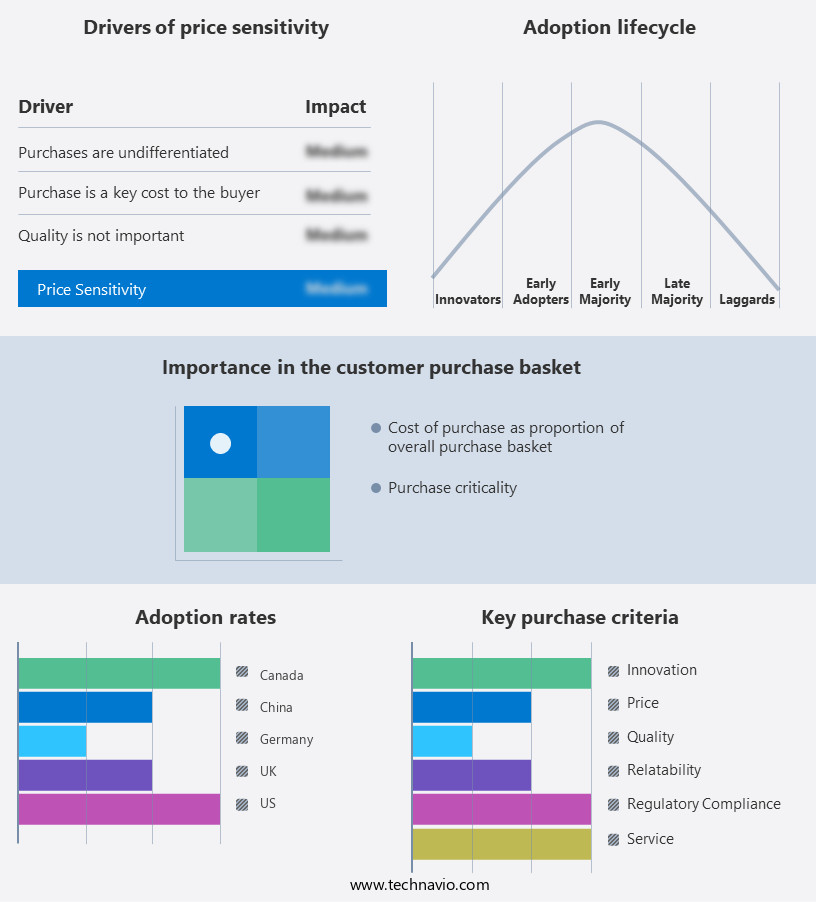
Customer Landscape of 3D Cell Culture Industry
Key Companies & Market Insights
Companies are implementing various strategies, such as strategic alliances, 3d cell culture market forecast, partnerships, mergers and acquisitions, geographical expansion, and product/service launches, to enhance their presence in the industry.
3D Biotek LLC - This company specializes in providing advanced 3D cell culture solutions through innovative devices, enhancing research capabilities and accelerating scientific discoveries.
The industry research and growth report includes detailed analyses of the competitive landscape of the market and information about key companies, including:
- 3D Biotek LLC
- BICO Group AB
- CN Bio Innovations Ltd.
- Corning Inc.
- Elveflow
- Emulate Inc.
- Greiner Bio One International GmbH
- Hamilton Co.
- InSphero AG
- Lonza Group Ltd.
- Merck KGaA
- MIMETAS BV
- PromoCell GmbH
- QGel SA
- REPROCELL Inc.
- Synthecon Inc.
- SynVivo Inc.
- Tecan Trading AG
- Thermo Fisher Scientific Inc.
- TissUse GmbH
Qualitative and quantitative analysis of companies has been conducted to help clients understand the wider business environment as well as the strengths and weaknesses of key industry players. Data is qualitatively analyzed to categorize companies as pure play, category-focused, industry-focused, and diversified; it is quantitatively analyzed to categorize companies as dominant, leading, strong, tentative, and weak.
Recent Development and News in 3D Cell Culture Market
- In January 2024, Merck KGaA, a leading life science company, announced the launch of its new 3D Cell Culture system, Sensoplex, designed for high-throughput screening applications. This innovative solution enables researchers to study cells in a more physiologically relevant environment, enhancing the predictability of drug discovery and development processes (Merck KGaA press release).
- In March 2024, Thermo Fisher Scientific and Corning, Inc. entered into a strategic partnership to expand their collaboration in the market. The partnership aimed to integrate Thermo Fisher Scientific's cell culture media and reagents with Corning's 3D Cell Culture platforms, offering researchers a comprehensive solution for their research needs (Thermo Fisher Scientific press release).
- In May 2024, Cytosurge AG, a Swiss company specializing in microfluidics and automation for cell culture, secured a Series C funding round of € 25 million. The investment was led by the Swiss investment firm, Lakestar, and would support the company's growth in the market and the development of new products (Cytosurge AG press release).
- In January 2025, the U.S. Food and Drug Administration (FDA) approved the use of 3D Cell Culture systems for certain toxicity testing applications. This approval marked a significant milestone in the acceptance and integration of 3D Cell Culture technologies in the pharmaceutical industry, providing an alternative to traditional 2D cell culture methods (FDA press release).
Research Analyst Overview
- The market encompasses a range of advanced technologies and applications, including apoptosis assays, high throughput screening, microfluidic devices, bioprinting technology, cytotoxicity testing, mechanical stimulation, oxygen gradients, process optimization, bioreactor scalability, and more. Apoptosis assays are crucial for understanding cell death mechanisms, while high throughput screening enables large-scale analysis of drug effects on cells. Microfluidic devices offer precise control over cellular environments, and bioprinting technology facilitates the creation of complex 3D structures. Cytotoxicity testing is essential for evaluating the safety of materials and compounds, while mechanical stimulation mimics physiological conditions for improved cellular response. Oxygen gradients and process optimization are vital for creating optimal cellular conditions in bioreactors.
- Bioreactor scalability is a significant focus, as these systems enable large-scale production of cells for various applications, such as drug screening assays, organoid generation, and tissue engineering. Additionally, 3D cell culture techniques enable advanced applications like cell proliferation assays, 3D cell imaging, protein expression analysis, automated cell handling, cell viability assays, and gene expression profiling. These techniques are essential for understanding cellular behavior and response to various stimuli, including cell adhesion molecules, nutrient delivery, waste removal, perfusion bioreactors, and cell differentiation. High content screening, angiogenesis assays, and tissue engineering applications further expand the market's scope, incorporating techniques like confocal microscopy, spheroid formation, cell migration assays, metabolic profiling, biocompatibility testing, scaffold biomaterials, and bioreactor systems.
- Computer-aided design and continuous process optimization further enhance the market's potential, ensuring the development of increasingly efficient and effective cell culture technologies. According to recent market research, the market is projected to grow at a rate of 15% annually, driven by increasing demand for advanced cell-based assays and applications in various sectors, including pharmaceuticals, biotechnology, and academia.
Dive into Technavio's robust research methodology, blending expert interviews, extensive data synthesis, and validated models for unparalleled 3D Cell Culture Market insights. See full methodology.
|
Market Scope
|
|
Report Coverage
|
Details
|
|
Page number
|
135
|
|
Base year
|
2023
|
|
Historic period
|
2018-2022 |
|
Forecast period
|
2024-2028
|
|
Growth momentum & CAGR
|
Accelerate at a CAGR of 16.6%
|
|
Market growth 2024-2028
|
USD 1382.4 million
|
|
Market structure
|
Fragmented
|
|
YoY growth 2023-2024(%)
|
13.9
|
|
Key countries
|
US, Germany, UK, China, and Canada
|
|
Competitive landscape
|
Leading Companies, Market Positioning of Companies, Competitive Strategies, and Industry Risks
|
Request Free Sample
What are the Key Data Covered in this 3D Cell Culture Market Research and Growth Report?
- CAGR of the 3D Cell Culture industry during the forecast period
- Detailed information on factors that will drive the growth and forecasting between 2024 and 2028
- Precise estimation of the size of the market and its contribution of the industry in focus to the parent market
- Accurate predictions about upcoming growth and trends and changes in consumer behaviour
- Growth of the market across North America, Europe, Asia, and Rest of World (ROW)
- Thorough analysis of the market's competitive landscape and detailed information about companies
- Comprehensive analysis of factors that will challenge the 3d cell culture market growth of industry companies
We can help! Our analysts can customize this 3d cell culture market research report to meet your requirements.
Get in touch







![]() Get the report (PDF) sent to your email within minutes.
Get the report (PDF) sent to your email within minutes.
Complimentary full Excel data with your report purchase.